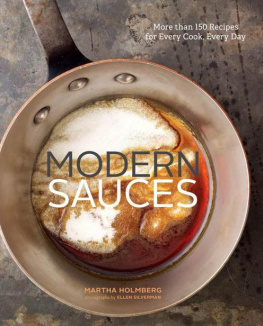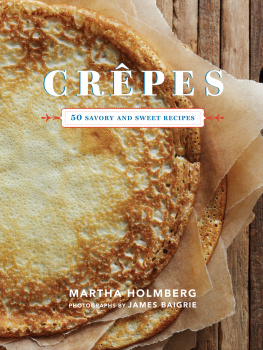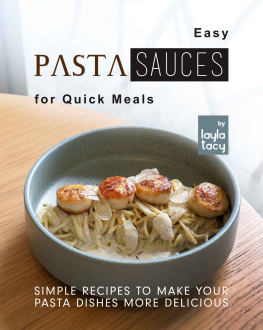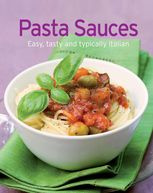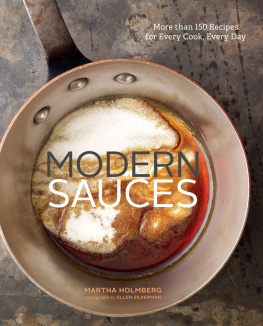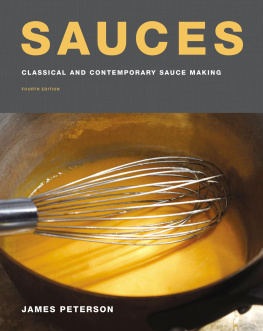
MODERN SAUCES
more than 150 recipes for every cook, everyday
MARTHA HOLMERG
photographs by ELLEN SILVERMAN

Contents
GETTING STARTED
A sauce is usually poured, ladled, dolloped, drizzled, or otherwise added to the more substantial ingredients in a dish. In other words, you could think of a sauce as just an add-on, an extra. For me, however, a sauce is the whole point. Its the main event, even though we might be talking about only two tablespoons of vinaigrette. Like an engine of deliciousness, a well-made sauce brings energy to a dish.
I wanted to write a book on sauces because I think sauce-making is such an important and gratifying part of cooking. Yet its often seen as being too tricky, too time consuming, or not relevant to everyday eating. But none of that is true! There are hundreds of sauces that reward you with a hugely delicious payoff for very little trouble.
My goal with this book is to show that any cook in any kitchen can make fantastic sauces for any meal, every day. Honestly, you can incorporate a homemade sauce into breakfast, lunch, or dinner, and by doing so youll elevate what might be a fine plate of food to a meal youre proud to have made and eager to eat.
WHAT EXACTLY IS A SAUCE?

A sauce can be anything from a mustard vinaigrette that you spoon over roasted beets to a red pepper hollandaise that you nap over grilled halibut to a hot fudge sauce that you eat with a spoon right out of the pot. No matter what form your sauce takes, it will share the three traits that are the source of power for all good sauces: intense flavor, complex character, and the alchemical ability to pull all of the elements of a dish together into a delicious unity.
The way I learned to develop those traits in a sauce is the subject of this book. I want to share everything that Ive discovered about sauces through my time at cooking school in Paris, my years as a food editor working with chefs and other amazing cooks, and my own cooking experiences as a private chef, caterer, and recipe developer as well as a home cook who needs to balance the pleasure of cooking with the constraints of a busy modern life.
I share recipes, of course, but, more important, I share my opinions, insights, and tricks, which I hope will have a big impact on your ability to understand and enjoy new sauces. In each chapter, I explain the essence of the sauce, I describe what youre trying to achieve, and I let you know what levers to push to get to your goal. Each time you cook anything, you arrive at moments when you need to make a decision that will nudge the dish in a certain direction. I call this process getting to delicious, and thats where I hope well go together in this book.
WHAT IS IN THIS BOOK?

The sauces Ive included are the ones that I find myself cooking month after month, year after year. Theyre versatile, your family and friends will love them, and theyre worth the time you put into them. Youll notice a bias toward French sauces. Thats because I learned to cook in France and French cuisine has introduced so many important sauces to the culinary world. But youll also find sauces inspired by Italy, Spain, Mexico, Morocco, Asia, the Middle East, and classic American comfort foodnot to mention sauces that simply reflect the flavors I love. Of course, this book cannot capture the range of sauces in every cuisine. A big world of sauces exists out there, and this is just my tasty little corner of it. But I think youll find that its plenty big.
HOW ARE THE RECIPES ORGANIZED?

Each chapter includes recipes that share a main ingredient, a key technique, or both. For example, all of the vinaigrettes in chapter two share the same method and most of the same ingredients, while the chocolate sauces in chapter fifteen use many different methods but all are made with chocolate or cocoa powder. My structure is loosely based on the French system of mother sauces, in which you have master sauces with lots of variations. Indeed, some of my sauce types are classic French mother sauceshollandaise, mayonnaise, beurre blancand I include a bchamel and a velout in the chapter on cream sauces. But Im deliberately omitting one of the big French mother sauce categories, brown sauces, because I just dont think theyre worth the effort and expense required of the home cook.
Ive also included several dozen recipes for dishes that showcase the sauces, perhaps in ways that are new to you or that will inspire you to go beyond the obvious. Of course, a vinaigrette is delicious on salad greens, but its also lovely on fish, meat, or fruit. I want cooks to be able to make their sauces and then to deploy them in inventive and satisfying ways.
START HERE, IMPROVISE TO INFINITY

The one-hundred-plus sauces in this book are just the tip of a delicious iceberg. Each one can be riffed on to bring in new dimensions: use a different herb, add some red pepper flakes, try pistachios instead of almonds, splash in some Calvados. Once you understand the fundamentals of a sauce, you can improvise to suit your mood, pantry, or menu. Youre equipped to create, delight, and nourishall of the reasons cooks love to cook.



THREE KEYS TO RECIPE SUCCESS: ORGANIZING YOUR WORK, LEARNING TO SEASON, AND JUDGING DONENESS

When Im just cooking rather than recipe developing, Im more an intuitive cook than a literal one. I make things up as I go along, using my technical training as a framework and then responding to the particular ingredients, equipment, weather, glasses of wine, appetites in the room, and mood that belong to me that day. So trying to write a recipe that distills all of those variables and locks them into numbers and words is hard. Every time you make a recipe, the world and its contents are a bit different, but here are three constants that will give you a good chance of success with the execution of any recipe.
DO YOUR MISE EN PLACE. I cant stress enough the importance of mise en place, which is a professional cooking term that means prep work (the translation from the French is more like put in place). Restaurants run on it and home kitchens should too. Mise en place is about breaking the work into small, manageable components, which is what Im going to do with this explanation. Here is how to think about mise en place:
Next page
